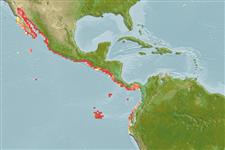Klassifizierung / Names
Namen | Synonyme | Catalog of Fishes(Gattung, Arten) | ITIS | CoL | WoRMS | Cloffa
Environment: milieu / climate zone / Tiefenbereich / distribution range
Ökologie
seewasser demersal; tiefenbereich 1 - 100 m (Ref. 96339). Tropical; 32°N - 7°S, 115°W - 78°W (Ref. 114953)
Eastern Pacific: Gulf of California to northern Peru.
Size / Gewicht / Alter
Geschlechtsreife: Lm ? range ? - ? cm
Max length : 119 cm TL Männchen/unbestimmt; (Ref. 111131)
Found in shallow water on sandy bottoms, sometimes adjacent to reefs (Ref. 12951). Found buried in the sand during the day (Ref. 12951). Moves into shallow bays at night to feed; prefers polychaete worms, but may take sea squirts (Ref. 12951). Produces litters of up to 15 pups. Maturity size of males at ca. 36 cm TL; birth size at ca. 11 cm TL (Ref. 114953).
Life cycle and mating behavior
Geschlechtsreife | Fortpflanzung | Ablaichen | Eier | Fecundity | Larven
McEachran, J.D., 1995. Narcinidae. Rayas eléctricas. p. 769-771. In W. Fischer, F. Krupp, W. Schneider, C. Sommer, K.E. Carpenter and V. Niem (eds.) Guia FAO para Identification de Especies para los Fines de la Pesca. Pacifico Centro-Oriental. 3 Vols. FAO, Rome. (Ref. 9259)
IUCN Rote Liste Status (Ref. 130435: Version 2025-1)
Nutzung durch Menschen
Tools
Zusatzinformationen
Download XML
Internet Quellen
Estimates based on models
Preferred temperature (Ref.
123201): 18.5 - 28.9, mean 25.8 °C (based on 82 cells).
Phylogenetic diversity index (Ref.
82804): PD
50 = 0.5000 [Uniqueness, from 0.5 = low to 2.0 = high].
Bayesian length-weight: a=0.01259 (0.00719 - 0.02203), b=2.90 (2.74 - 3.06), in cm total length, based on LWR estimates for this species & (Sub)family-body (Ref.
93245).
Trophic level (Ref.
69278): 3.0 ±0.18 se; based on food items.
Widerstandsfähigkeit (Ref.
120179): niedrig, Verdopplung der Population dauert 4,5 - 14 Jahre. (Assuming fecundity<100).
Fishing Vulnerability (Ref.
59153): High to very high vulnerability (71 of 100).
🛈
